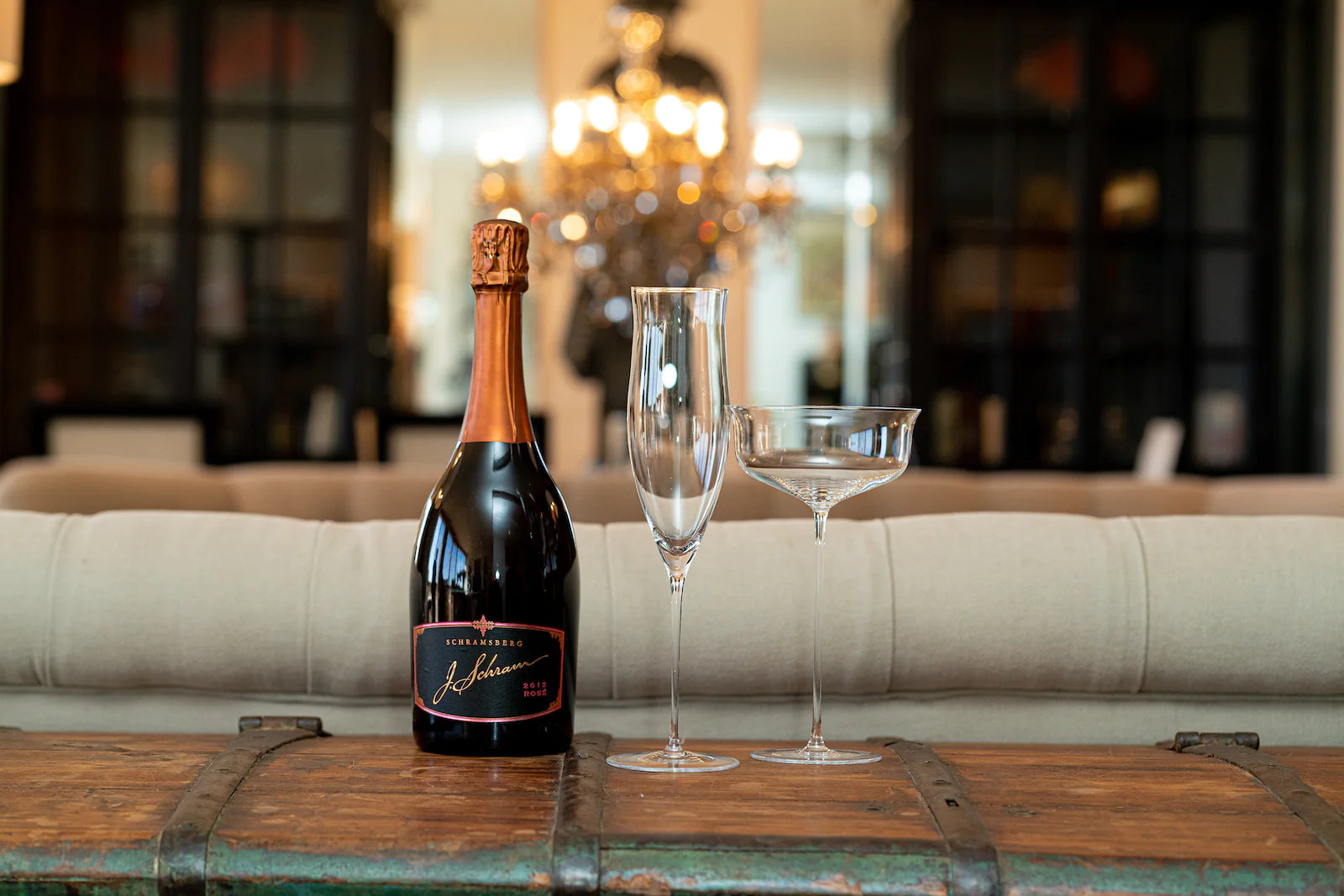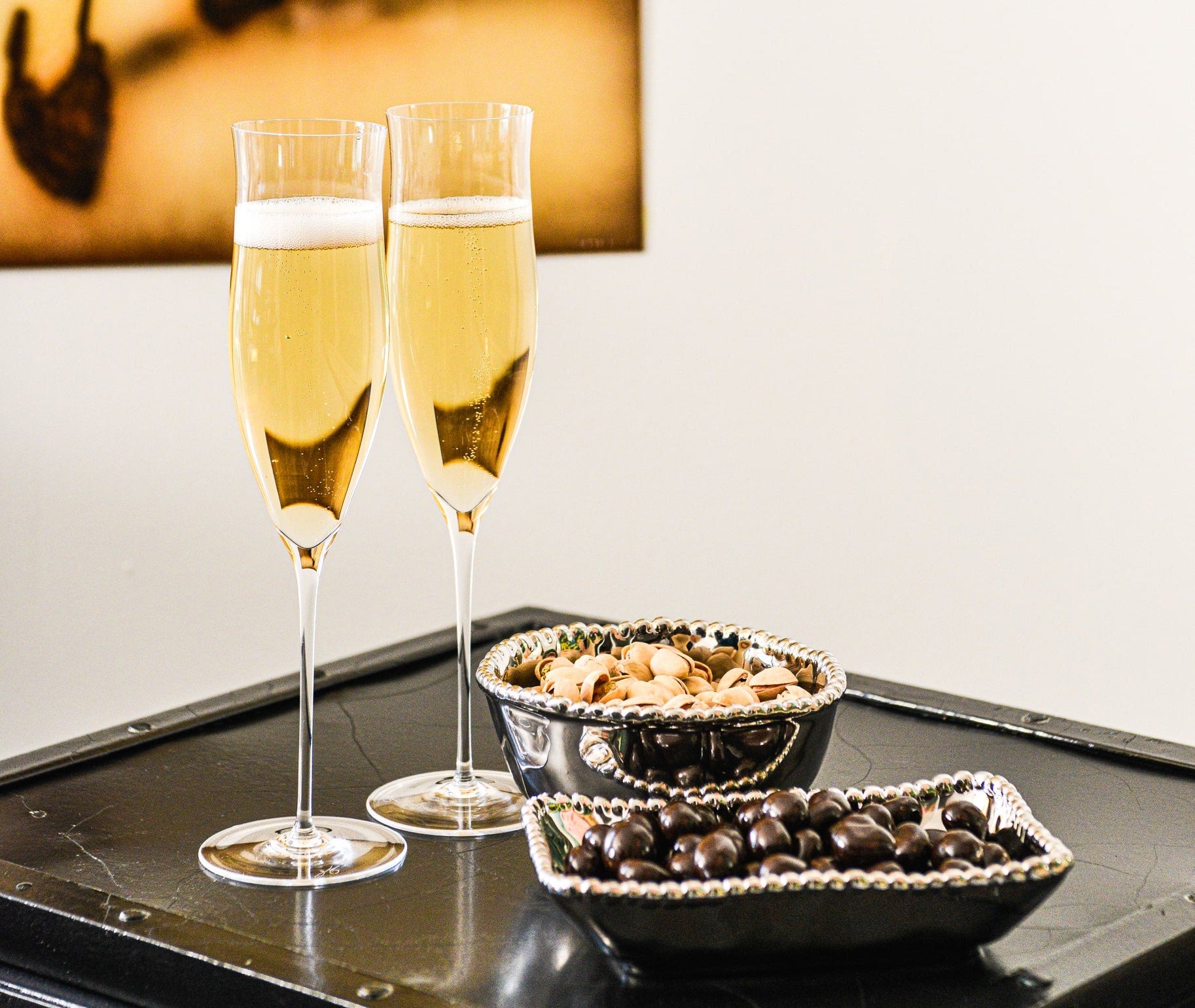Champagne, Home Entertaining, Red Wine, White Wine
Sipping in Style: A Guide to Choosing the Perfect Stemware

In entertaining, it’s not just the drink, but also the glass that’s holding the drink that matters. The fine stemware you serve your beverages in is designed to highlight the qualities within and enhance your sensations, making for an unforgettable tasting experience.
With so many different styles of stemware to choose from, it’s important to consider several factors before making your selection - material, design and price for value are just a few of the details that help determine the right collection for your home.
Fran Berger, a world-renowned home entertaining designer and consultant, defines the importance of living fabulously through the details of your home. Take a look at Fran’s guide for everything you need to know when choosing the perfect stemware to sip from.
Types of Stemware
Choosing a style of stemware for your drink of choice will assist in highlighting the best characteristics, such as flavor and aroma. Learn more about the different types of glassware and what they are used for.
Red Wine Glasses
Red wine glasses usually feature tall, long stems and large, globe-shaped bowls. Red wine glasses are designed to mellow the strong tannins and allow the aromas and flavors of the wine to fully release. To accomplish this, red wine glasses typically have a larger bowl than white wine glasses. This seemingly small difference has the power to change your entire drinking experience.
The best stem length for red wine glasses comes down to personal preference. Fran Berger’s Signature Red Wine Glass rests effortlessly in the hand, presenting a long and delicate stem made from 100% lead-free crystal. Stemless wine glasses are optional for a more casual celebration. Stemless glasses are fine for red wines because they can be served warmer than white wines.
White Wine Glasses
White wine glasses are intentionally designed to preserve delicate floral aromas and crisp, cool temperatures. Unlike red wine, white wines do not need a lot of space to breathe. Instead, white wine glasses usually have a smaller bowl and opening at the rim of the glass to maintain cool temperatures and preserve the aromas.
Stem length is also an important factor for white wine because a longer stem helps to prevent hands from warming the contents within the glass. White wine is best served cooler than room temperature - between 45-50° degrees Fahrenheit.
Champagne Glasses
Champagne glasses come in four different, distinct shapes: flute, tulip, wide tulip, and coupe. The shape and size of your Champagne glass can be an important factor in your tasting experience. A slimmer body, much like the one Fran Berger’s Signature Champagne Flutes display, makes for a bubbly mouthfeel, whereas a larger opening, such as the coupe, can encourage the bubbles to disperse faster.
Stem length is also an important factor for Champagne because a longer stem helps to prevent hands from warming the contents within the glass.
Cocktail Glasses
Cocktail glasses, commonly called coupe or martini glasses, are thinly stemmed glasses with wide, cone-shaped bowls. This recognizable shape allows the interesting aromas of the mixed drink to fully develop and the large mouth allows the drinker to get close to fully experience the scents and taste. This shape also encourages small, delicate sips to enjoy the flavors.
These glasses are most often used to serve cocktails without ice, or 'up’. The term “up” refers to any mixed drink that is shaken or stirred together with ice and served chilled. This includes a variety of cocktails, like a Cosmopolitan, Vodka Martini, or Strawberry Daiquiri.
Beer Glass
Beer glasses come in a variety of shapes and sizes, the standards being the pint glass, Weizen (or wheat) glass, goblet, tulip, snifter, and stein. The most frequently used types of beer glasses feature a wide, tall, cylinder body shape. The shape of the beer glass is designed to enhance the aromas and preserve the head, or the frothy foam on top of the beer. There are also beer glasses, like the mug, that have a handle to prevent your hands from warming the contents within.
Factors to Consider While Selecting Stemware
The wine-tasting experiences you create in your home have everything to do with the glasses in your collection. You want a high-quality glass that highlights the important details of your drink of choice but still looks and fits comfortably in your hand for all your entertaining affairs.
Material
-
Crystal
Crystal is a high-quality material for crafting wine, champagne and cocktail glasses because of its ability to be spun very thinly. The thickness of the rim of a glass affects your tasting experience, from allowing more space for the aromas to how you perceive the taste. Although it can be spun thin, crystal is extraordinarily strong in comparison to regular glass and is less likely to break under similar circumstances. -
Glass
Glass, though not as strong as crystal, is a non-porous material, which prevents the corroding of soap and chemicals when washed. Another benefit of using glass is that it can be less expensive than crystal. -
Stainless Steel
Stainless steel glasses are ideal for drinking chilled wine or beer. Glasses that are made with food-grade stainless steel do not impact or change the flavor of your beverage, so you can still have an enjoyable drinking experience. This material is also good for retaining temperatures, as stainless steel won’t heat too quickly in warmer spaces.
These wine glasses are best for traveling, outdoor gatherings and for use on boats.
Design
Depending on your priorities, knowing what to look for in terms of design will help you find the right stemware for your collection. Whether you prefer a shorter stem, an oversized bowl, one that feels light and airy in your hands, or a bold and charismatic glass that stands out in a crowd, having an idea of design in mind when looking for your next set of glasses will help to make your decision easier.
Value
Finding glassware of high value does not always mean it will come at a higher cost. Knowing what you plan to invest in your glassware will help you to find a set that is valuable and still within your budget.
How to Care for Stemware
High-quality glasses require gentle care when washing to preserve their use and value over time, ensuring that you always have the best possible drinking experience. Glasses that haven't been washed or stored correctly can accumulate odors and toxins that will adversely affect the quality of your drinks.
Follow these tips for caring for your home’s stemware including cleaning, drying and storing.
Cleaning
-
Handwashing
If your glass has staining, soak it in diluted warm white vinegar for 5 minutes before washing.
Wet your glass in warm or room-temperature water. Avoid using too hot of water, as extreme temperature changes can cause the glass to crack or shatter.
Gently wash the glass inside and out thoroughly, using a little bit of dish soap and a nylon net scrubber or soft sponge to avoid scratching the glass. For a dazzling shine, you can also wash your glassware in a high-quality, professional glass cleaner, like Restaurant Crystal Clean.
Dry with a lint-free, microfiber cloth for a pristine shine.
-
Dishwasher
Most glassware can be cleaned in the dishwasher, however, stems that are too long or delicate can easily break during the wash cycle. Cleaning crystal glasses in the dishwasher can be unsafe because the high heat and harsh detergents can damage or break the glass. Check the manufacturing details of your stemware. Fran Berger Signature stemware should not be cleaned in the dishwasher.
Storing
When it comes to storing delicate glasses, it is best to keep them in a clean, dry place so that scratches and dust do not accumulate. Placing them on open shelves or cabinets helps to keep them from shattering.
The rim of the glass is the most fragile part of wine and champagne glasses, so storing your longer glassware right side up is preferable. Stemmed glasses can also be hung upside down by mounting a wine glass rack on or under a surface, such as a wall or a kitchen cabinet. This helps to avoid water spots from drying on your wine glasses.
Beer mugs and stemless glasses can be stored upside down to avoid dust and germs from collecting inside, especially if they are not used daily. Do not stack your glassware.
The Art of Pairing Stemware with Food
Science has proven that the overall design of glassware can impact your experience of tasting both your drink and food. The body and shape of the glass help direct the contents to where they will taste best on the palate, affecting the overall sensations. The opening at the rim of the glass can also open all of the aromas on the nose. When done right, different combinations of food and drink - sweet, floral, bitter, acidic, and more - can bring you a new tasting experience every time.
Complement
Combinations often work best when they share some common flavor or aroma elements. Consider what flavors go well together when choosing what food to pair with your stemware and drink. Here are some examples of complementary pairings:
The acidity found in both food and certain wines blends well with one another, such as a tart red wine paired with zesty or spicy dishes. The Pinot Noir glass has a thinner rim, which makes for a seamless sip and allows the contents to flow smoothly along the palate, perfect for tasting all of the flavors fully.
As the driest of Champagnes, Brut Nature successfully complements most dishes from the sea, specifically raw fish because of the highly acidic and intense minerality of flavors. For less effervescence, use the wide opening of a coupe Champagne glass to help disperse the bubbles and allow the nose to take in every aroma.
A tall imperial pint glass allows for an even flow for the deep, roasted flavors of a stout to pair perfectly with other dark flavors, like a chocolate truffle.
Contrast
On the other hand, some stemware pairs better with contrasting flavors to make for an overall enjoyable dining experience. Lighter wines, like rosé, sparkling, and white wine, usually prefer contrasting pairings.
Rosé Champagne is a light red wine expressing various flavors of red berries, citrus, and floral that suits contrasting flavors of smoked salmon and roasted duck. The tulip glass is ideal for Champagne because it has a narrow mouth and a wider bowl, which allows the bubbles to float to the top and highlights the fruity flavors.
Cleanse
Some meals can leave you feeling heavy - picking a stemware that releases your drink appropriately will help to cleanse your palate without overfilling you.
The effervescence of Champagne and sparkling wines lifts lingering flavors and brightens the palate. Try serving Prosecco in a tall Champagne flute to encourage smaller sipping and send the wine along the tongue. Prosecco pairs well with medium-intense meals, such as meats flavored in spicy curries.
Beer is also known as one of the world’s best palate cleansers. A sip of cool, crisp light beer can reduce bolder-flavored dishes and the head can leave your mouth feeling refreshed. Follow Beer Association’s Beer and Food Matching Chart to help pair your favorite ale.
Balance
Some wines and sparkling wines can be intense and bold in flavor. Be sure to choose a wine that will not overpower the seasoning in your food.
Wine and cheese are a match made in gourmet heaven. Buttery, sweet, and rich in flavor, semi-hard cheeses balance well with a dry wine, especially with Haber Family Vineyards Chardonnay. The opening of a Chardonnay glass allows for more wine to fill the mouth and take in the combination of flavors.
For cocktails, always start with the base spirit you plan to use in your cocktail or mixed drink. The vodka in a French Martini pairs perfectly with fresh fruit flavors and sweet desserts.
Sipping Never Felt So Good
The glass you choose does more than just look good in your hand. The overall shape and design of stemware can affect the contents of your drink and enhance the entire dining experience. With the advice of home entertaining expert, Fran Berger, you can feel confident in acquiring the perfect set of stemware for your next dining occasion! For more insights into curating affordable and luxurious moments within your home, learn more from Fran Berger here.





















